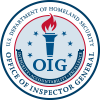U.S. Customs and Border Protection’s (CBP) Office of Field Operations (OFO) uses the Centralized Area Video Surveillance System (CAVSS) at land ports of entry (LPOEs) to increase the safety of the public, employees, and property, but improvements are needed to address video surveillance system issues. Specifically, CAVSS experienced widespread recording gaps, instances of poorquality video and audio, areas of inadequate video and audio coverage within LPOEs, and inadequate privacy protections for detainees being held at LPOEs.
Open Recommendations
| Recommendation Number | Significant Recommendation | Recommended Questioned Costs | Recommended Funds for Better Use | Additional Details | |
|---|---|---|---|---|---|
| 1 | No | $0 | $0 | ||
| We recommend CBP’s Border Security Deployment Program Project Management Office: a. assess the impact that video surveillance system network (patching and scanning) updates have on live feeds and recording capabilities; b. develop and implement a mitigation plan as warranted based on the impacts identified in (a); and c. consider notification options to alert video surveillance system operators of recording gaps. | |||||
| 2 | No | $0 | $0 | ||
| We recommend the CBP Office of Field Operations Executive Assistant Commissioner, Enterprise Services Executive Assistant Commissioner, and appropriate CBP program offices: a. conduct a program review to identify improvements required for the video surveillance system, equipment, and network infrastructure at land ports of entry and consider alternative solutions when infrastructure cannot be upgraded; and b. establish a risk-based process for upgrading video surveillance system and equipment including factors such as operating environment and limitations at each land port of entry. | |||||
| 3 | No | $0 | $0 | ||
| We recommend CBP’s OFO Directors of Field Operations collaborate with CBP’s Border Security Deployment Program Project Management Office and relevant program offices to implement a process to ensure: a. continued awareness of and compliance with video surveillance requirements at land ports of entry, such as implementation of a training program for new and existing Centralized Area Video Surveillance System operators; and b. land ports of entry personnel coordinate with CBP’s Border Security Deployment Program Project Management Office and other program offices when upgrading video surveillance equipment or re-purposing rooms. | |||||
| 4 | No | $0 | $0 | ||
| We recommend CBP’s Border Security Deployment Program Project Management Office, in coordination with other relevant program offices, establish a process requiring feasibility studies to identify network infrastructure needs for new video surveillance system equipment and installations and incorporate these outcomes as warranted. | |||||
| 5 | No | $0 | $0 | ||
| We recommend the CBP Office of Information and Technology Assistant Commissioner implement a process to ensure video and audio surveillance equipment installed complies with applicable security and privacy controls required by DHS network standards, CBP information security policies, and Centralized Area Video Surveillance System Design Standards for design and operation, as applicable. | |||||
| 6 | No | $0 | $0 | ||
| We recommend CBP’s Border Security Deployment Program Project Management Office, in collaboration with CBP’s OFO Directors of Field Operations, take immediate action to ensure all land ports of entry have the required privacy protections for hold rooms with lavatory facilities. | |||||
| 7 | No | $0 | $0 | ||
| We recommend CBP’s Border Security Deployment Program Project Management Office, in collaboration with CBP’s OFO Directors of Field Operations, survey Centralized Area Video Surveillance System operators annually to obtain feedback related to video and audio equipment. | |||||


